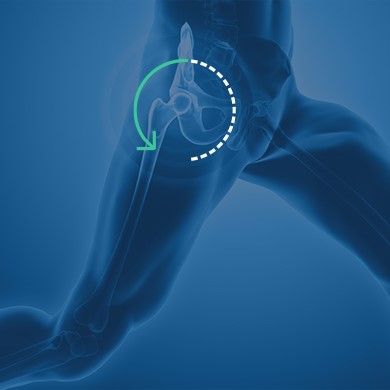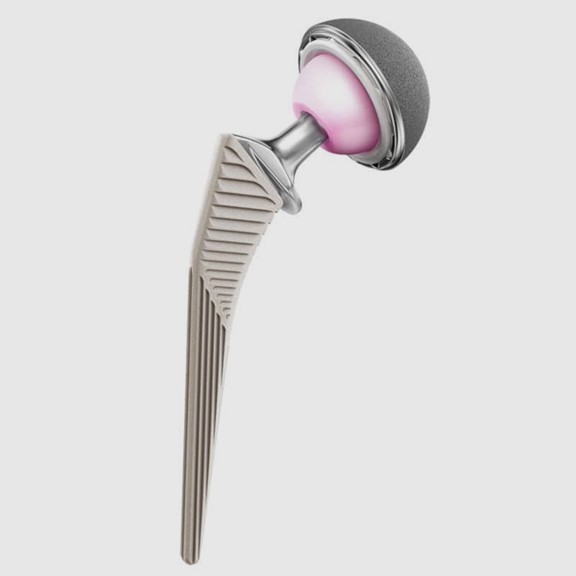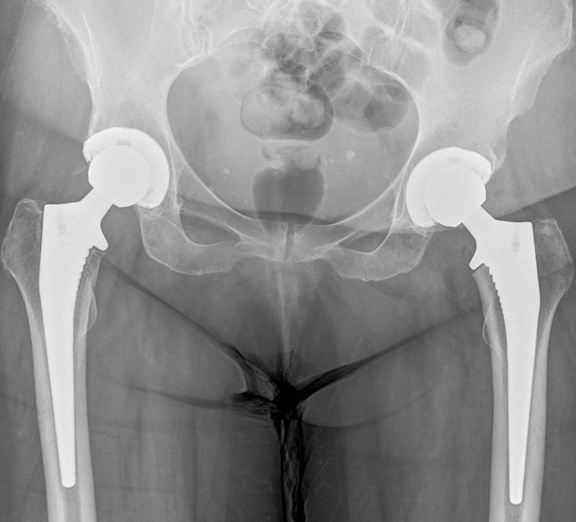Hip Arthritis
Osteoarthritis is a common condition affecting more than 10 million people in the UK. It is a disease process in which the joint surface wears away resulting in underlying bone becoming exposed. During weightbearing activities, the exposed bones rub against each other causing pain, swelling and inflammation.
Often there is no obvious cause for the development of arthritis but some associated risk factors are:
- Previous injuries such as ligament tears or fractures
- Body weight
- Childhood developmental or acquired hip joint abnormalities
- Genetic factors
- Alignment of the limb
- Inflammatory arthritis

Symptoms
Generally, symptoms begin in patients over the age of 50 and the incidence increases with age. It can occur in younger patients as a result of trauma or other childhood injuries.
Common symptoms are:
- Pain – worse after exercise, often causes disturbed sleep
- Stiffness – worse in the morning or after having been seated for a time
- Functional Limitation – Difficulty bending forwards to pick items up off the floor or tie shoelaces
- Swelling – Intermittent episodes of joint swelling often accompanied by a flare up of pain
- Limp – The pain can cause you to limp or cause other altered gaits
The symptoms will deteriorate with time and often the symptoms can fluctuate with time and the weather.
Treatments
Nonoperative
In the early stages of arthritis, the majority of people can be treated without surgery.
Treatment involves:
- Optimizing pain killer medication often using anti-inflammatories
- Reducing weight and so reducing the forces the joint has to withstand
- Stopping strenuous exercises or work
- Using a stick or crutch
- Maintaining movement and increasing muscle strength with physio directed exercises.
- Joint injections using steroid and local anaesthetic or hyaluronic acid
With time, as the joint becomes more worn out or nonoperative treatment fails, joint replacement surgery is recommended.
Operative
During a total hip replacement, the arthritic, damaged “ball and socket” joint is removed and replaced with an artificial joint (prosthesis). The majority of patients experience a rapid reduction in pain from the hip joint after surgery and find that they are able to move more easily and have an improved quality of life.

Through an incision over the side of the hip, the joint can be replaced with an artificial socket and a metal stem with an artificial ball mounted on the end of the stem. This is performed via a posterior approach (see FAQs) as it provides the best longevity and function for the replaced hip. I use modern implants which allow the bone to incorporate onto the implant (uncemented) and I use both ceramic, metal and polyethelene bearing surfaces tailored to the individual patient.

You will be admitted on the day of surgery having not eaten for the preceding 6 hours prior to the operation (nil by mouth). The anaesthetist will talk to you regarding the type of anaesthetic (spinal or general anaesthetic); it is preferable to have a spinal anaesthetic as there are fewer side effects, improved pain control and a speedier rehabilitation whilst in hospital. See FAQ section spinal or general anaesthetic.
After surgery patients generally remain inpatients for 1-3 days. Patients mobilise full weight bearing on the same day of their surgery and generally go home using a stick or crutch for 1-2 weeks. In the vast majority of cases, within a week after a hip replacement, patients will experience a significant improvement in their hip function.
Risk of surgery
Common
- Bleeding – Bruising following the surgery is common very occasionally a blood transfusion or iron tablets may be required. Rarely, the bleeding may form a collection within the hip joint which may require a further operation to remove it.
- Blood Clots – Deep vein thrombosis (DVT) is a blood clot in a vein. The risk of developing a DVT is greater after surgery (especially lower limb surgery). A DVT can pass in the blood stream and become lodged in the lungs causing a pulmonary embolus (see below). To limit the risk of DVTs forming you will be given stockings to wear on your legs whilst an inpatient and a daily tablet or injection to thin the blood. Moving early after surgery is one of the best ways to prevent blood clots from forming.
- Pain – The hip will be sore after the operation. Pain will improve with time and generally is much improved by the 2 week post operative mark. Rarely, pain can be a chronic problem.
- Implant wear and loosening – With modern operating techniques and new implants, hip replacements last in excess of 20 years. In some cases they can fail and this is usually as a result of the plastic liner wearing out.
Less Common
- Infection – You will receive antibiotics just before the operation starts and the procedure is performed in a sterile theatre. The wound site may become red, hot and painful. There may be a discharge of pus or fluid. This is usually treated with antibiotics and an operation to washout the joint may be necessary. In rare cases, the implant may be removed and replaced at a later date (revision surgery). The infection can sometimes lead to sepsis (blood infection) and strong antibiotics are required.
- Dislocation – The new hip is less stable than your original hip. A dislocation may occur while the tissues are healing following surgery if the hip moves beyond its normal range. The highest risk is during the first 6 weeks before scar tissue forms. If the hip does dislocate the joint will need to be put back into place without the need for surgery. If the hip keeps dislocating a revision surgery may be necessary.
- Leg Length – The operated leg may appear shorter or longer than the other. The most important requirement at the end of the operation is to produce a stable joint. Occasionally, this may involve making the leg a fraction longer following surgery. This rarely requires further treatment and often the leg may have been slightly shorter as a result of the arthritis.
Rare
- Pulmonary Embolism – This happens when a blood clot (DVT) breaks off and lodges within the lungs. It can affect breathing and is a serious condition that can be fatal.
- Poor scars – The wound may become red, thickened and painful (keloid scar). This is more common in Afro-Caribbeans.
- Nerve Injuries – The sciatic nerve is the main nerve at risk and is identified and protected throughout the operation. It can occasionally be damaged which can give rise to weakness of the foot and need for a splint while it recovers.
- Fracture – Bone may be broken when the new implant is inserted. This may require fixing during the operation and could result in protective weight bearing for a few weeks after surgery.
- Blood vessel injury – Blood vessels around the hip may be damaged, this can require further surgery by the vascular surgeons
Robotic Surgery is the future in joint replacement surgery
The use of robotic technology has several benefits.
- Improved accuracy and precision – There is always a small chance of human error in any operative procedure, robotic assistance adds an extra level of accuracy and precision to the surgery1-4.
- Increased consistency – In conjunction with being more precise, robotic technology is more consistent than conventional methods5.
- Reduced complications – The technology enables precision implantation of the socket component to the nearest degree and enables recreating a patient’s correct leg length and offset to the nearest millimetre. This degree of accuracy improves the postoperative results and reduces the risk of dislocation and leg length discrepancy.
- Greater chance of restoring movement and mobility – As a result of a smaller incision, less soft tissue releases and greater accuracy of implantation many patients experience reduced recovery periods as well as an increased chance of restoring freedom of movement and complete mobility.
These benefits result in improved outcome metrics
- Better patient outcomes – It has been shown that patients who receive robotic surgery report better functional outcomes and experience fewer readmissions to hospital. They also require less rehabilitation than patients who undergo conventional hip replacement.
- Higher patient satisfaction – patients can return to their daily activities and work sooner after robotic hip surgery and this translates into improved patient satisfaction ratings.
- Lower long-term costs – Patients who receive robotic hip surgery tend to have fewer complications meaning less return visits to hospital. The CORI™ robotic system is an image free preoperative mapping system eliminating the cost and implications of a CT or MRI scan6. Patients also recover quicker and are able to get back to work sooner.
Is Robotic hip replacement surgery better?
Yes. Robotic surgery has been shown to deliver better results compared to conventional hip replacement. Improved accuracy, consistency and more reliable recreation of leg length, offset and cup positioning following a CORI™ robotic hip replacement result in better patient outcomes.
- Herry Y, Batailler C, Lording T, Servien E, Neyret P, Lustig S. Improved joint-line restitution in unicompartmental knee arthroplasty using a robotic-assisted surgical technique. Int Orthop. 2017;41:2265-2271.
- Batailler C, White N, Ranaldi F, Neyret P, Servien E, Lustig S. Improved implant position and lower revision rate with robotic-assisted unicompartmental knee arthroplasty. European Society of Sports Traumatology, Knee Surgery, Arthroscopy (ESSKA) 2018.
- Jaramaz B, Nikou C, Casper M, Grosse S, Mitra R. Accuracy validation of semi-active robotic application for patellofemoral arthroplasty. Paper presented at: International Society for Computer Assisted Orthopaedic Surgery; June 17-20, 2015; Vancover, Canada.
- Jaramaz B, Mitra R, Nikou C, Kung C. Technique and Accuracy Assessment of a Novel Image-Free Handheld Robot for knee Arthroplasty in Bi-Cruiciate Retaining Total Knee Replacement. EPiC Series in Health Sciences. 2018;2:98-101.
- Gregori A, Picard F, Lonner J, Smith J, Jaramaz B. Accuracy of imageless robotically assisted unicondylar knee arthroplasty. Paper presented at: International Society for Computer Assisted Orthopaedic Surgery; June 17-20, 2015; Vancover, Canada.
- Ponzio DY, Lonner JH. Preoperative Mapping in Unicompartmental Knee Arthroplasty Using Computed Tomography Scans Is Associated with Radiation Exposure and Carries High Cost. J Arthroplasty. 2015;30(6):964-967.

